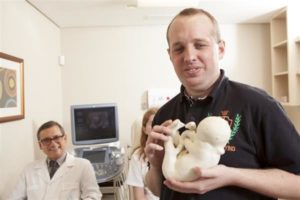Love At First Touch: Brazilian Doctor Uses 3D Printing To Help Blind Parents Feel Baby’s Ultrasound
When Ana Paula Silveira got pregnant, she and her husband, Alvaro Zermiani, dreamed about seeing the face of their child during her first ultrasound exam. But weeks later, they got to feel it instead.
 Both Ana Paula and Alvaro, who live in São Paulo, Brazil, are legally blind. Their son, Davi Lucas, was strong and healthy, but there was no way their eyes could see the first grainy glimpses of their baby on the ultrasound monitor.
Both Ana Paula and Alvaro, who live in São Paulo, Brazil, are legally blind. Their son, Davi Lucas, was strong and healthy, but there was no way their eyes could see the first grainy glimpses of their baby on the ultrasound monitor.
They decided to take a different path. The couple made a trip to the office of Dr. Heron Werner, a gynecologist and obstetrician working at the DASA clinic in Rio de Janeiro. He agreed to follow Ana Paula through her pregnancy.
Dr. Werner uses a 3D printer to make lifelike models from images obtained by a GE ultrasound machine. “From the moment we got to the high-quality ultrasound exam, through the possibility of 3D printing it, I realized that it could also serve to enhance the prenatal experience of visually impaired pregnant women,” Dr. Werner says.
Ana Paula agrees. “Holding the small fetus at 12 weeks is an indescribable feeling,” she says. “Following up on our son’s evolution allowed us to have this feeling of being whole, because we feel with our hands.”
Dr. Werner got the idea for 3D printing babies during a visit to Rio’s National Museum, which was then using a tomography machine to digitize its ancient Egyptian exhibits. “We thought, why not use [medical imaging technology] for printing fetus models,” he says.
Ana Paula says that being able to hold a printed model of her son was a great gift. “When we touched the second model, with Davi’s face, we realized his resemblance to us,” she says. “Thanks to the exams and printing, we were able to not only know that our baby was growing healthy but also to have a very real contact and establish a very strong involvement with our son.”
The ultrasound machine, called Voluson E10, is the first ultrasound system in the OB/GYN field with built-in 3D-printing capability. With this, doctors can help parents better understand congenital defects such as cleft lips, abnormal extremities or abdominal wall defects. In some cases, 3D printing can enhance discussions about surgical planning and serve as educational tools.
Source: gereports










